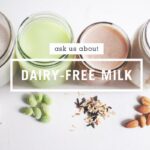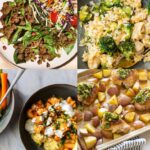Embark on a culinary adventure where delicious dairy-free meals meet budget-friendly brilliance! This guide unveils the secrets to crafting flavorful, satisfying dishes without breaking the bank. Discover affordable dairy-free staples, ingenious cooking techniques, and savvy meal-planning strategies that transform your kitchen into a haven of economical, plant-based goodness. Prepare to be amazed by the versatility of inexpensive ingredients and the sheer joy of creating delectable, dairy-free masterpieces.
We’ll explore creative substitutions for expensive dairy alternatives, revealing how to achieve creamy sauces and decadent baked goods using readily available pantry items. From mastering the art of batch cooking to extending the shelf life of your dairy-free creations, this comprehensive guide empowers you to embrace a vibrant, dairy-free lifestyle without compromising your budget or culinary satisfaction. Get ready to unlock a world of flavor and affordability!
Affordable Dairy-Free Staples
Embracing a dairy-free lifestyle doesn’t have to break the bank. Many affordable alternatives to dairy products are readily available, offering delicious and nutritious options for budget-conscious cooks. By strategically selecting staples and planning your meals, you can enjoy a rich and varied dairy-free diet without compromising your finances. This section will guide you through selecting cost-effective dairy-free staples, providing recipes and storage tips to maximize your budget and minimize food waste.
Inexpensive Dairy-Free Milk Alternatives, Cheeses, and Yogurt Substitutes
Choosing affordable dairy-free alternatives is key to keeping your grocery bill down while maintaining a delicious and varied diet. The following table Artikels some budget-friendly options, their price ranges, nutritional highlights, and where you can typically find them. Remember that prices may vary depending on location and season.
| Product | Price Range (per unit) | Nutritional Highlights | Where to Buy |
|---|---|---|---|
| Soy Milk (unsweetened) | $1.50 – $3.00 | Good source of protein; often fortified with calcium and vitamins. | Most supermarkets, large grocery stores |
| Oat Milk (unsweetened) | $2.00 – $4.00 | High in fiber; naturally creamy texture. | Most supermarkets, health food stores |
| Coconut Milk (full-fat, canned) | $1.00 – $2.50 | Rich in healthy fats; adds creaminess to dishes. | Most supermarkets, Asian grocery stores |
| Tofu | $2.00 – $4.00 | Excellent source of protein; versatile in cooking. | Most supermarkets, Asian grocery stores |
| Nutritional Yeast | $5.00 – $10.00 (larger container) | Good source of B vitamins; cheesy flavor. | Health food stores, some supermarkets |
| Cashew Cheese (homemade) | Variable, depending on cashew price | High in healthy fats; creamy texture. | Homemade – requires cashews, water, lemon juice, and seasonings. |
| Plain Unsweetened Soy Yogurt | $2.00 – $4.00 | Good source of protein; can be used in both sweet and savory dishes. | Most supermarkets, health food stores |
Budget-Friendly Dairy-Free Recipes
These recipes utilize the affordable staples listed above, demonstrating how to create delicious and satisfying dairy-free meals without excessive spending.
Creamy Tomato Soup with Tofu
This vibrant soup is both hearty and budget-friendly. Imagine a deep crimson broth, subtly thickened with silken tofu, its richness contrasting with the bright acidity of the tomatoes. A sprinkle of fresh basil adds a final touch of freshness.
Ingredients: 1 (28 ounce) can crushed tomatoes, 1 block silken tofu, 1 small onion (diced), 2 cloves garlic (minced), 1 tbsp olive oil, vegetable broth (as needed for desired consistency), salt and pepper to taste, fresh basil (for garnish).
Instructions: Sauté onion and garlic in olive oil until softened. Add crushed tomatoes and bring to a simmer. Blend in silken tofu until smooth and creamy. Add vegetable broth to reach desired consistency. Season with salt and pepper. Garnish with fresh basil.
Savory Oat Milk Risotto
This creamy risotto offers a comforting and satisfying meal. Picture a bed of pearly rice, each grain coated in a velvety oat milk sauce, subtly infused with the earthy aroma of mushrooms.
Ingredients: 1 cup Arborio rice, 4 cups oat milk, 1 cup vegetable broth, 1 cup mushrooms (sliced), 1 small onion (diced), 2 cloves garlic (minced), 1 tbsp olive oil, nutritional yeast (to taste), salt and pepper to taste.
Instructions: Sauté onion and garlic in olive oil until softened. Add rice and toast for 1-2 minutes. Add mushrooms and cook until softened. Gradually add oat milk and vegetable broth, stirring constantly until rice is cooked through and creamy. Stir in nutritional yeast, salt, and pepper.
Simple Cashew Cheese and Veggie Wraps
These wraps are quick, easy, and perfect for a light lunch or snack. Visualize vibrant colored vegetables nestled in soft tortillas, all bound together by a creamy cashew cheese.
Ingredients: 1 cup raw cashews (soaked overnight), 1/4 cup water, 2 tbsp lemon juice, salt and pepper to taste, your favorite vegetables (e.g., bell peppers, spinach, carrots), whole wheat tortillas.
Instructions: Blend soaked cashews, water, and lemon juice until smooth and creamy. Season with salt and pepper. Spread cashew cheese on tortillas and add your choice of vegetables. Roll up and enjoy.
Storing Dairy-Free Staples to Maximize Shelf Life
Proper storage is crucial for extending the shelf life of your dairy-free staples and minimizing waste. Understanding the best storage methods for each product will help you save money and reduce food spoilage.
For example, store unopened cans of coconut milk in a cool, dry place. Once opened, transfer the contents to an airtight container and refrigerate for up to 5 days. Soy milk and oat milk should be refrigerated after opening and consumed within the date printed on the carton. Tofu should also be refrigerated and ideally used within a week of opening. Nutritional yeast, stored in an airtight container in a cool, dark place, can last for several months. Homemade cashew cheese should be stored in an airtight container in the refrigerator for up to 5 days. Soy yogurt should be treated similarly to dairy yogurt.
Dairy-Free Cooking Techniques for Saving Money
Embracing a dairy-free lifestyle doesn’t have to break the bank. By employing smart cooking techniques and substituting ingredients strategically, you can create delicious and satisfying meals without sacrificing your budget. This section will explore cost-effective methods for preparing dairy-free staples and creating flavorful dishes using inexpensive pantry items.
Dairy-Free Cream Sauce Comparisons
Choosing the right base for your dairy-free cream sauce significantly impacts cost. Let’s compare popular options: cashew cream, often lauded for its richness, requires soaking cashews, which adds time. Potato cream, on the other hand, utilizes readily available and inexpensive potatoes, making it a budget-friendly choice. Both offer creamy textures, but their flavor profiles differ, with cashew cream lending a subtle nuttiness and potato cream possessing a more neutral taste.
- Cashew Cream: While delivering a luxuriously creamy texture and subtle nutty flavor, cashew cream can be more expensive than other options, especially if cashews aren’t purchased in bulk. The soaking time also adds to the preparation. The cost-effectiveness depends heavily on the price of cashews in your region.
- Potato Cream: Using readily available potatoes makes this a significantly cheaper option. The flavor is mild and easily adaptable to various dishes, allowing for greater culinary flexibility. It’s a quick and easy method, requiring minimal preparation time.
Inexpensive Dairy-Free Recipes
These recipes utilize budget-friendly pantry staples to create satisfying and flavorful meals.
Creamy Tomato Pasta with Chickpeas
- Sauté one chopped onion and two cloves of minced garlic in a tablespoon of olive oil until softened.
- Add one (28-ounce) can of crushed tomatoes, one (15-ounce) can of chickpeas (drained and rinsed), and a teaspoon of dried oregano.
- Simmer for 15 minutes, allowing the flavors to meld.
- Blend a portion of the sauce using an immersion blender or regular blender for a creamier texture.
- Season with salt and pepper to taste.
- Serve over your favorite pasta.
Hearty Lentil Soup
- In a large pot, sauté one chopped onion, two carrots (chopped), and two celery stalks (chopped) in two tablespoons of olive oil until softened.
- Add one cup of brown or green lentils (rinsed), four cups of vegetable broth, one teaspoon of dried thyme, and a bay leaf.
- Bring to a boil, then reduce heat and simmer for 30-40 minutes, or until lentils are tender.
- Season with salt and pepper to taste.
- For added creaminess, blend a portion of the soup with an immersion blender before serving.
Black Bean Burgers
- Mash one (15-ounce) can of black beans (drained and rinsed) with a fork.
- Add ½ cup cooked brown rice, ½ cup breadcrumbs, ½ chopped onion, 1 clove minced garlic, 1 tablespoon of chili powder, and salt and pepper to taste.
- Mix well to combine all ingredients.
- Form the mixture into patties.
- Cook in a lightly oiled skillet over medium heat for about 5 minutes per side, or until heated through and slightly browned.
- Serve on buns with your favorite toppings.
Affordable Dairy-Free Ingredient Substitutions
Expensive dairy-free ingredients can be easily substituted without compromising the final product’s taste or texture. For instance, expensive coconut cream can often be replaced with full-fat coconut milk, providing a similar creaminess at a lower cost. Similarly, expensive nutritional yeast, used for a cheesy flavor, can be partially replaced with nutritional yeast flakes or even a combination of spices to create a similar taste profile.
Resource Guide for Affordable Dairy-Free Eating

Embarking on a dairy-free lifestyle doesn’t have to break the bank. With careful planning and the right resources, you can enjoy delicious and nutritious dairy-free meals without sacrificing your budget. This section provides a comprehensive guide to navigating the world of affordable dairy-free eating, equipping you with the tools and knowledge to make informed choices.
Valuable Online Resources for Dairy-Free Cooking on a Budget
Finding reliable sources for budget-friendly dairy-free recipes and meal planning can significantly simplify your journey. The following table highlights some excellent online resources that offer a wealth of information and inspiration. These resources provide a mix of recipes, meal planning tips, and community support, ensuring you’re never short on ideas or encouragement.
| Resource Name | Description | URL |
|---|---|---|
| Budget Bytes | This popular website offers a wide range of affordable recipes, many of which can be easily adapted to be dairy-free. Expect clear instructions and beautiful photography. | [Insert URL here] |
| Minimalist Baker | Known for its simple recipes using minimal ingredients, Minimalist Baker frequently features dairy-free options that are both budget-friendly and delicious. | [Insert URL here] |
| Vegan Richa | This blog specializes in Indian-inspired vegan (and therefore often dairy-free) recipes, many of which are inexpensive and use readily available ingredients. Expect vibrant colors and bold flavors. | [Insert URL here] |
| The Spruce Eats | A comprehensive resource with articles, guides, and recipes on various culinary topics, including dairy-free cooking. Their articles often include tips for saving money. | [Insert URL here] |
Bulk Buying Versus Smaller Quantities of Dairy-Free Products
The decision to buy dairy-free products in bulk versus smaller quantities involves a careful cost-benefit analysis. Consider the following factors to determine the best approach for your specific needs and shopping habits.
Bulk buying often offers significant cost savings per unit, particularly for staple items like nuts, seeds, and dried fruits commonly used in dairy-free baking and cooking. Imagine a large, burlap sack overflowing with vibrant, sun-dried cranberries, their deep red hue promising delicious additions to muffins and oatmeal. However, bulk purchasing requires adequate storage space and may lead to food waste if items aren’t consumed before their expiration date. A visual comparison would be a large, transparent container filled with oats, standing proudly next to a small, almost empty package, highlighting the difference in quantity and cost-effectiveness.
Smaller quantities, on the other hand, offer greater flexibility and reduce the risk of spoilage. A brightly colored shelf, neatly organized with smaller packages of various dairy-free milks and yogurts, each with its own vibrant label, represents the convenience and reduced waste associated with this approach. This option is particularly suitable for individuals or smaller households with limited storage space or those who prefer to experiment with different brands and flavors.
Deciphering Food Labels to Identify Hidden Dairy and Make Informed Choices
Reading food labels meticulously is crucial for avoiding hidden dairy ingredients and making informed purchasing decisions. Dairy can lurk in unexpected places, often disguised under different names. Imagine a close-up shot of a food label, with a magnifying glass highlighting the ingredients list, specifically focusing on terms like “whey,” “casein,” “lactalbumin,” or “milk solids,” which all indicate the presence of dairy.
A step-by-step approach is essential:
1. Check the ingredients list: Carefully examine the ingredients list, paying close attention to any words that might indicate dairy derivatives. Look for terms such as whey protein, casein, lactose, milk solids, and butterfat. These are common dairy components that may be hidden in seemingly innocuous products.
2. Understand potential disguises: Be aware that dairy can be disguised under different names. For instance, “natural flavors” or “modified food starch” can sometimes contain dairy derivatives. Always check the manufacturer’s website or contact them directly if you are unsure.
3. Look for certifications: Look for certifications such as “vegan” or “dairy-free” to ensure the product is free from dairy ingredients. These certifications provide assurance that the product has undergone rigorous testing and meets specific standards.
4. Compare products: Compare different brands and products to find the most affordable options that meet your needs. Don’t be afraid to switch brands if you find a more budget-friendly alternative that doesn’t compromise on quality or taste.
By following these steps, you can confidently navigate the supermarket aisles, ensuring that your dairy-free choices align with both your budget and your dietary needs.
Mastering the art of dairy-free cooking on a budget is not just about saving money; it’s about unlocking a world of culinary creativity and embracing a healthier lifestyle. By implementing the strategies Artikeld in this guide – from strategic shopping and clever substitutions to efficient meal planning and batch cooking techniques – you’ll confidently navigate the world of dairy-free cuisine while keeping your wallet happy. So, roll up your sleeves, gather your ingredients, and embark on a delicious journey of affordable, dairy-free delight!
Question Bank
What are some common hidden dairy ingredients to watch out for?
Hidden dairy can lurk in unexpected places! Check labels for casein, whey, lactose, and milk solids. Also be aware of ingredients like butter powder, and some types of processed meats and snacks.
Can I freeze all dairy-free baked goods?
While many dairy-free baked goods freeze well, some textures may change upon thawing. Cakes and muffins generally freeze well, while delicate pastries may be better enjoyed fresh.
How do I know if my dairy-free milk substitute has gone bad?
Dairy-free milks spoil differently. Check for signs of souring (off odor), curdling, or unusual texture. Always refer to the “best by” date on the packaging.
Are all dairy-free cheeses created equal in terms of cost?
No, prices vary greatly depending on brand, type (e.g., cheddar vs. mozzarella), and ingredients. Experiment with different options to find your favorites within your budget.


